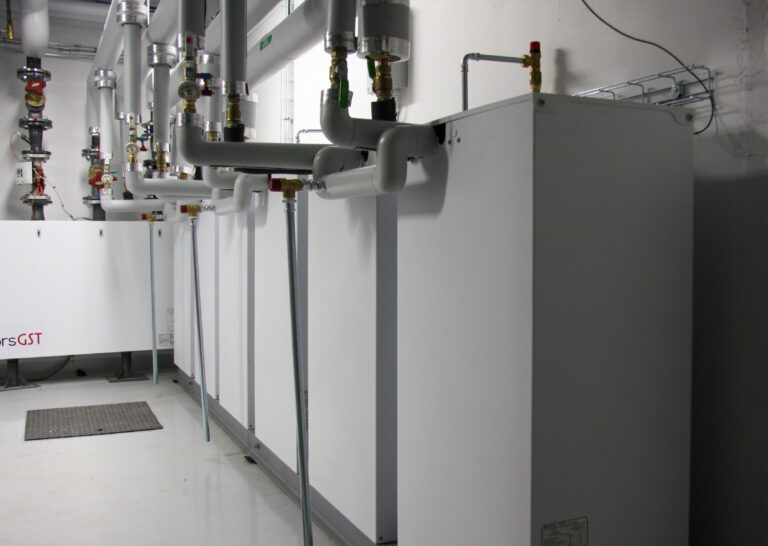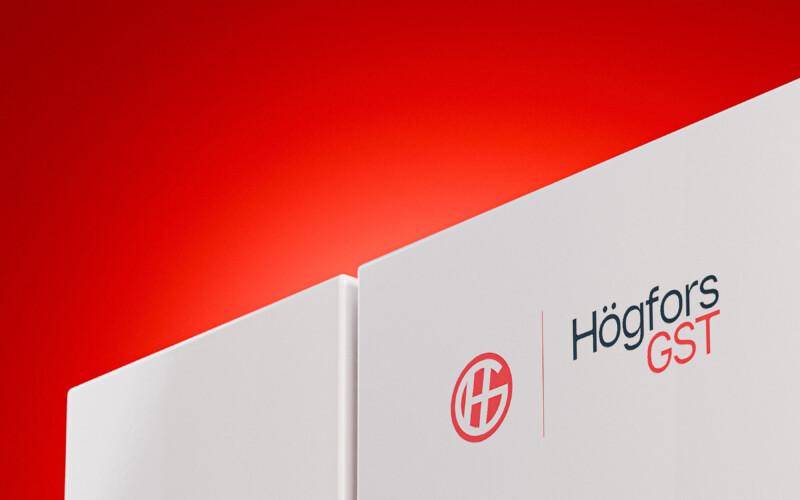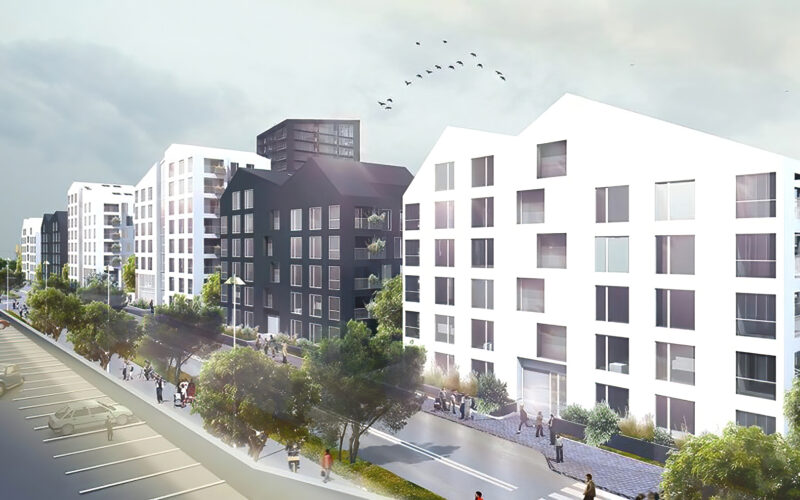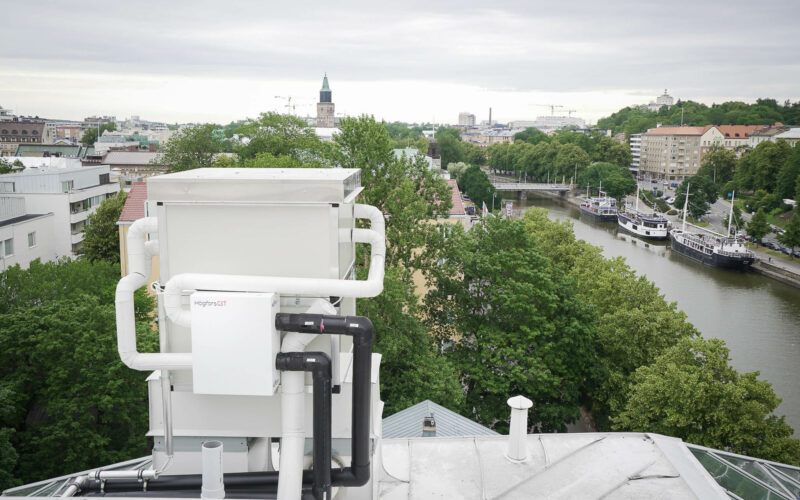In this article, we will elaborate on the operation of a geothermal and exhaust heat recovery system, and in particular their heat pump. Geothermal is a technology that transfers heat from the ground to the house and heat recovery transfers heat from the exhaust air to the house.
The heat pump has four main components for operation. Condenser, evaporator, compressor and expansion valve. As a rough example, the action is as follows:
- The condenser is hotter than the water coming to the heat pump
- The water comes to the condenser and its heat rises
- The evaporator is colder than the collector fluid entering the heat pump
- The collector fluid enters the evaporator and its heat drops
The geothermal system is based on geothermal energy. Its average temperature is about +7°C. Collection fluid, which is about 0°C, is discharged from the evaporator of the ground source heat pump. The liquid warms up to about +3°C degrees in the ground and returns to the evaporator where it cools down again to 0°C. If the earth is not able to heat the collector fluid to +3°C degrees, but only to +2°C degrees, this is a sign that the heating capacity of the geothermal wells is not high enough. In other words, the cooling capacity of the heat pump is thus higher than that of the geothermal wells. This is a problem that can cause geothermal wells to freeze and overload. Therefore, the number and depth of the heat wells should always be sufficient and preferably even slightly oversized.
In a heat recovery system the exhaust air functions as the heat source. That is basically air blown out of the house. Its average temperature is +21°C. However, its temperature varies quite a bit depending on for example the outdoor temperature and ductwork, which is often poorly insulated in older houses. Exhaust air temperature is often +19°C in winter, while in summer it is easily above +23°C. The temperature of the heat source varies, unlike geothermal heat. There is oscillation in the heating power of the heat source, which is worse when the exhaust air temperature is lower and again better when the exhaust air temperature is higher. This means that the cooling capacity of the heat pump should be adjustable to prevent it from freezing. The cooling power could not be greater than the heating power from the heat source. Exhaust air contains a lot of energy because of its temperature, but also because of its humidity, which makes it an excellent source of thermal energy.
However, the temperature and humidity of the exhaust air vary and this adds additional requirements to the system. Therefore, a change in the exhaust air temperature can cause a problem if the heat pump cools the heat source too much. Therefore, the heat pump should “be able” to calculate the cooling capacity if there is not enough energy available from the heat source, this may be due to changes in temperature or humidity in the exhaust air.
Example:
- The amount of air removed from the house is 1000 liters / second. Exhaust air tempereture is +19°C. The exhaust air can be cooled at approximately 19 kW. If the cooling capacity is higher, the heat recovery cell begins to freeze.
- The amount of air removed from the house is 1000 liters / second. Exhaust air temperature is +19°C. The exhaust air can be cooled at approximately 22 kW. If the cooling capacity is higher, the heat recovery cell begins to freeze.
- The heat pump should therefore be able to adjust the cooling power between 19kW and 22kW.
However, this fluctuation of the exhaust air temperature is not the biggest change in the characteristic of the heating source requiring adjustment. Even greater is the variation in the amount of exhaust air, ie how the air is removed from the house. The amount of air is not always the same, but it changes as needed. For example, to eliminate the feeling of draft, the amount of air is often reduced as the colder outdoor temperature drops. Often there are also booster periods where the amount of air can be doubled compared to the amount of air normally used.
The modern way is to adjust both air volumes to the outdoor temperature. That is, the enhanced airflow is on when a larger airflow is needed and at other times the system operates with a lower airflow. Both of these air volumes are also reduced the colder it is outside and the boosted air volume is completely disabled when the outdoor temperature falls below a certain limit, e.g. -5 °C degrees (this is done to eliminate the feeling of draft).
The amount of air is infinitely adjustable in order to achieve the best living comfort. This also means that the heating power of the heat source changes radically. And that also means that the cooling capacity of the heat pump must be adapted to the heating power of the heat source (or else the heat source freezes). In this example, the maximum heating power of the heat source is 38.5 kW and the minimum is 19.5 kW. That is, the heat pump should be able to adjust the cooling output steplessly during this time.
Inverter heat pumps
The word inverter means that the power of the compressor is continuously controlled. That is, an inverter compressor with a maximum output of 50kW, for example, can operate steplessly in the power range of 10-50 kW, for instance. Therefore this kind of heat pump would suit the
On / off heat pump
There are two types of on/off heat pumps on the market: single compressor and dual compressor models. If a single compressor device were to be used in a heat recovery project, it would be very difficult to design and even if it was found to be of sufficient power, the end result would be poor in terms of system performance.
If a heat pump with a cooling power of 38.5 kW required by the heat source were found, this would mean that the heat pump would be either 0 kW (unit off) or 38.5 kW when it’s running. What happens when the air volumes are lower? The answer: the heat pump switches on and off constantly.
A single compressor can only run for a short period of time before it has to shut down to prevent the heat source from freezing. The appliance stays off for 5 minutes and then switches on again for a while. This could be compared to a car where the accelerator pedal has no more than two positions: no throttle or full throttle.
Another thing to keep in mind is that also the fluctuating exhaust air temperature is causing even more stress for system.
If the unit has two compressors, the situation is a bit better. If the maximum power is the same 38.5 kW, then 0kW, 19.25 kW or 38.5 kW power levels can be used. So a two compressor unit performs a bit better than a single compressor unit, but it still doesn’t get near the optimum result like an inverter heat pump.
The inverter heat pumps also have advantages on the heating side because they can control the heating power in the same way as the cooling power. This allows for greater COP and thanks to flexibility, a smaller amount of buffer capacity is needed than with on/off devices.
In geothermal systems, the benefits of inverter technology are not quite as great as they have a more consistent heat source. With a properly dimensioned thermal well field, high level of adjustability is not required when the wells provide more energy than the heat pump cooling capacity is.
Nevertheless, in heat recovery solutions, inverter heat pumps are the best equipment available and their benefits are clearly better than traditional on/off heat pumps.






